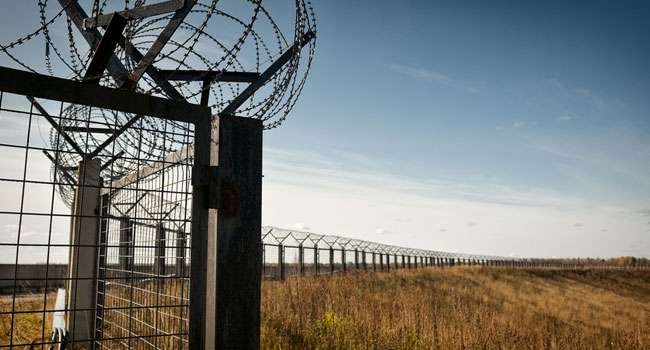
Perimeter Benefits
The world of physical security has changed in response to the pervasive threat of terrorism around the globe.
Most everyone is aware that crash-rated, anti-terrorist vehicle
access control barriers, barricades, bollards and gates are
standard security tools at government facilities, from embassies
to courthouses and capitols to a host of other locales.
They also tend to be quite visible at airports, especially leading
onto the tarmac, in rental car facilities and at access to parking lots and structures.
More and more, such equipment is found at soft targets; ranging from hotels,
arenas and other areas where many people congregate.
However, there are certain industries that are at the forefront for terrorist attacks
and other forms of vandalism. These industries need to be protected more
heavily than others. This starts with perimeter access. The following three industries
are at the top of this list.
Petro-Chemical Facilities
The first industry benefiting from crash-rated barriers is the petro-chemical industry.
Refineries, storage areas, distribution centers, and other facilities need protection
so that the entire community does not have to face the repercussions of a
terrorist attack. The vulnerability of the world economy to the loss of refining
and delivery capacities is highly publicized. This has helped the petrochemical and
hydrocarbon industries reach the apex of terrorists’ lists for car bombing.
Today, at production and distribution facilities, more is needed at checkpoints
than simply verifying if a person is authorized to enter. Security systems must be
employed that can stop a vehicle, even one weighing 64,000 lbs going 50 mph, dead
in its tracks. That vehicle must be stopped where you want it stopped.
Danger points at refineries, distribution centers or storage facilities are where
lots of trucks come in and out each day. Just one terrorist with one truck could put
a facility out of business for months. That’s why most major petrochemical and
hydrocarbon processing companies, employ vehicle access control anti-terrorist
barriers, bollards and gates. Companies such as Chevron, ExxonMobile, Conoco,
BP, Shell and others employ them.
The most commonly used barriers will stop and destroy a truck weighing up
to 15,000 lbs., traveling at 50 mph. In an emergency, the thick steel plates pop out
of the ground within 1.5 seconds. When integrated properly into a total system,
including fences, lights, alarms, gates and other security components, vehicle barriers
are a key measure in preventing threats to sensitive resources.
Bollard systems operate individually or in groups up to 10. They are typically deployed
in the up position and lowered only to allow authorized vehicles to pass. They
go up and down quickly and are the perfect solution for entrances with high traffic.
The bollards employed in the oil and gas industry are tested to stop and destroy
an attacking vehicle weighing 15,000 lbs moving at 50 mph.
In addition to barriers and bollards, crash gates are also used at oil and gas
producing, distribution and storage facilities literally around the globe, from South
Africa to North America. A linear crash gate will withstand the impact of a 15,000
lb vehicle striking the gate at 50 mph. Clear openings range from 12 to 30 feet.
Public Water and Ot her
Utility Companies
Treatment plants, dams and other utility
locations are at risk if the wrong
individual is able to get to them. A
major problem is that they are often in
remote locations, making them an easy
target for terrorists. A barrier will keep
a harmful person or vehicle out, detain
them and alert the proper authorities
of the breach.
For this reason, leading public water
supply and control districts including
the Federal Bureau of Reclamation, the
Tennessee Valley Authority and other
major utilities use barricades, bollards
and crash gates to protect dams, canals,
treatment plants and other infrastructure
facilities. A favored barricade for
remote locations is one that incorporates
a special locking system which
prevents terrorists from disabling or dismantling
it. Because the barricade is in
a remote area, it needs to be especially
reliable. Although set in a foundation
only 18 inches deep, the barricade will
survive and operate after a 5.4 million
foot pound impact, protecting against a
second hit from another vehicle. That’s
equivalent to a 65,000 lb truck hitting
it at 50 mph. Typically, the barricade is
furnished with a debris screen which reduces
visual and physical access to the
intra-barricade for security and safety
purposes. It will also deflect explosives,
such as hand grenades.
Cruise Ports
At cruise lines and other port destinations,
a barrier will stop any speeding
automobile from getting past guard
posts. The Port of Sydney Harbour and
many other cruise destinations employ
barricades, bollards, crash gates and
other vehicle access units to protect
passengers, employees, and cargo and
infrastructure facilities.
The anti-terrorist barriers that protect
the international cruise ship terminal
in Sydney will lie flat in the road until
activated, at which point they spring up
at a 45-degree angle and effectively stop
a speeding vehicle in its tracks.
In Sydney, vehicles not authorized
to enter simply cannot get past the
guard post at the Overseas Passenger
Terminal at Circular Quay where approximately
90 vessels dock during
the busy summer months. More than
160,000 passengers today are protected
from vehicle assault per year.
Wherever Vehicle Att ack
is a Possibility
It’s self-evident that the world of physical
security has changed in response
to the pervasive threat of terrorism
around the globe. Where many facility
managers were once criticized for taking
extreme and expensive perimeter
security measures, the question today
is not whether to implement them, but
simply how best to do it.
Whether you work in petro-chemicals,
marine transportation, public
waterworks or any other industry that
makes a good target for terrorist vehicle
attack, you can protect your employees,
customers and the entire community
with a crash-rated security
barrier.
This article originally appeared in the March 2015 issue of Security Today.